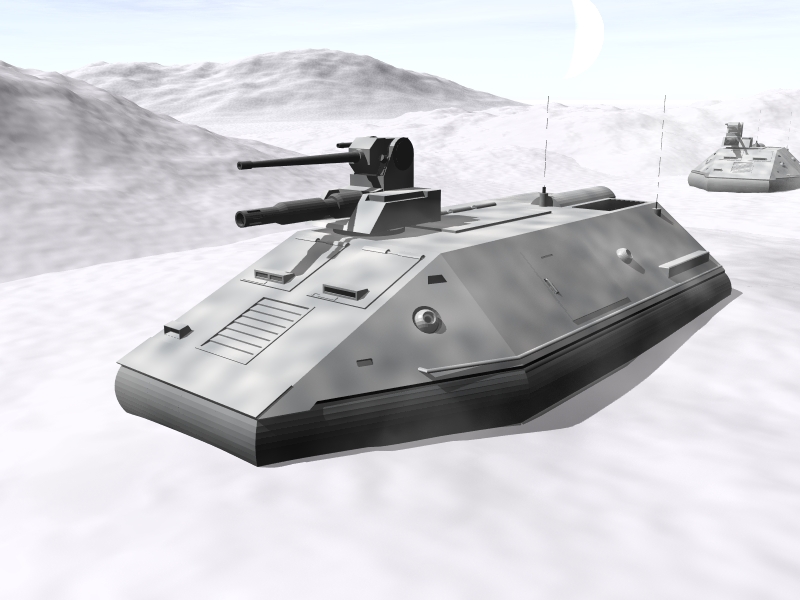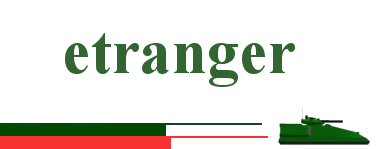
Kangaroo
Family
Hover Armoured
Personnel Carrier
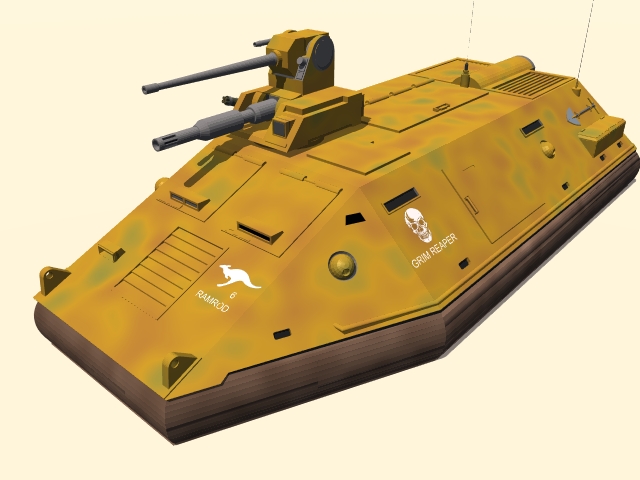
|
Introduction
The
Kangaroo family of AFVs has proven to be a very
popular and long lasting design. Based on a Bavarian design, subsequent
Australian modifications produced a robust and iconic vehicle which remains
popular to the current day, while
Bavarian variants are also in widespread service. The Kangaroo-IV is now long out of regular service
on Earth but can be found in many colonies on the frontiers or in remote parts
of the core. Evolved later models are
still in service with frontline military forces. The highly publicised use of
the vehicle by the Tanstaafl Free Legion on Aurore has once again raised the vehicle’s profile.
Narrative
Sergeant Mike Vincent
swore colourfully as his helmet smashed into the jagged interior of the
lurching Kangaroo. He’d started his military career riding around in Roos with 4RAR and had volunteered for special
forces in part to get away from them, and now he was back in one. Like
most armoured personnel carriers they were cramped and uncomfortable and the
air cushioned ride could spark nausea in even the strongest stomachs. Their
driver, an enthusiastic second generation Bavarian colonist from the eastern
backwoods, was swerving dramatically through the stands of Broadtop
trees on their way to the besieged ranch. ‘Two minutes!’ yelled
Vincent over the screaming noise of the MHD turbine. The six dismounts were
crammed into the old style seats in the back, three to a side, with their
Russian assault rifles braced between their knees. The were
the usual TFL mixture – grim faced volunteers from the militia, a highly
professional Pole and two Texan wannabes seeking adventure. Vincent had come
here to help train the TFL in long distance patrols and survival, but
casualties had led him into the combat units. ‘Kees. Keep your eyes open.
Lets try and get the first shot in.’ The taciturn
Flemish gunner grunted in agreement, never taking his attention from the
gunnery display. Vincent didn’t know the man’s background, but he got the job
done and was ruthlessly efficient. Vincent checked
quickly that the other two Roos were still in close
formation. The Bugs were probably going to be ‘tactical’ when they arrived so
they had to have all their firepower massed for maximum shock effect. The 25mm cannon opened fire suddenly. Short staccato bursts rapping out from the remote turret punctuated by shell casings chinking off the roof.
The
battle was on.
|
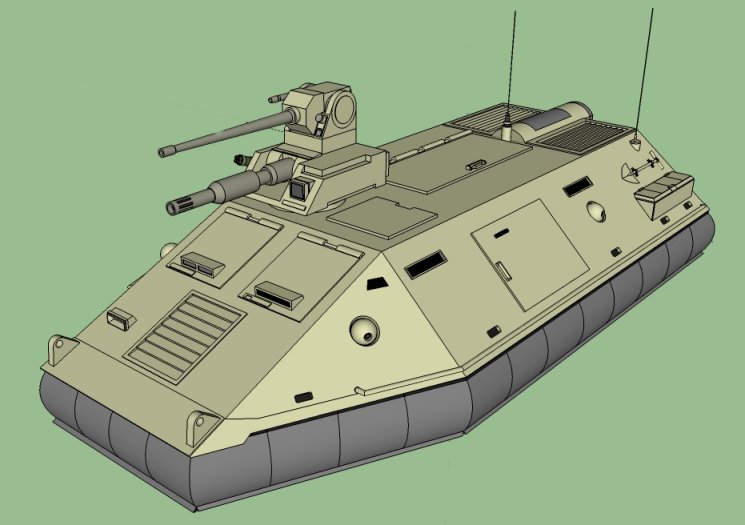
|
The
Kangaroo IV has its roots in an Australian defence capability requirement raised in
the early 2250s to replace the hover APCs then being
used in Australian cavalry units in Australia and New Canberra. The key design
requirement was a combination of speed, endurance, low signature and
survivability. The Bavarian LkPzTr-IV design was used
as the basis of the Australian model, hence the holdover of ‘IV’ in the
nomenclature. There was a substantial redesign of powerplant,
vectronics and armour composition that built upon the
Garten designed LkPzTr-IV’s
existing traits of endurance and simplicity.
The
Kangaroo-IV was designed to operate over long distances in close concert with
hover tanks and when the first prototypes proved successful large scale
production was begun at the DMA factories at Benowa on the Gold Coast. The ‘Roo
was popular in service, although there were several improvements made over the
years in A, B and C models. The Kangaroo is still in service with the
Australian Defence Force, but only in the liaison role or occasionally in low
profile peacekeeping duties.
The
original armament of a conventional 25mm autocannon, a
close in defence system and four ball mounts capable of mounting a range of
machine gun remained standard throughout its service in Australia. However one
of the great strengths of the design was its flexibility and its ease of
modification, and the Australians alone introduced a range of variants for
reconnaissance, surveillance and fire support. Export customers would go even
further in altering the range of weapon systems and roles. Tanstaafl
purchased 120 surplus Kangaroo-IVs from Australia in 2298 which arrived via a
French freighter early in 2299. These Roos were armed
with a French designed turret with heavy plasma gun and 25mm autocannon replacing the single cannon of the Australian
version, otherwise few changes were made. The vehicles were delivered to the
newly formed Tanstaafl Free Legion to equip their
rapid response units and mechanised companies. The step change in combat power
the Roos gave the Tanstaaflians
made a great difference in their ability to keep pushing the Kafers away from the key areas.
The high
level of media attention given to the TFL raised the profile of the Kangaroo
again and surplus sales increased including further batches to Tanstaafl including support weapon modifications. A number
of mercenary companies operating in the French Arm have recently acquired small
batches of Kangaroos from Australia or other operators.
Another
major operator of the early model Kangaroo-IV is Iran which operates the
vehicle as the Gerdbâd
or
Whirlwind having acquired a large number of the vehicles surplus from Australia.
The Iranians operate the vehicle within their second line divisions where its
low maintenance burden is highly appreciated. The Iranians have a significant
indigenous repair capability which is capable of building more Kangaroos from
scratch.
Kangaroo-IV
TFL
Type: Hover APC
Crew: Driver, gunner, commander
Weight 4000 kg Armor:
Plenum: 2 All Faces. 10
Armament: 2 DunArmCo
Mini- 12 Machineguns in ball mounts, one on either side of the forward hull;
CLP-1A Plasma gun in remote turret; 25mm conventional autocannon
in remote turret on top of main turret.
Signature: 5
Evasion: 6
Sensor
Range: 10 km
Range
Finder Bonus: +1
Cargo: 6 passengers and 2000 kg
Max
Speed: 200 kph
Cruising
Speed: 180 kph
Combat
Movement: 420 m
Off-Road
Mobility: Full
Power
Plant:
0.5 MW hydrogen fuel cell Fuel Capacity. 270 kg
Fuel
Consumption: 15 kg/hr
Endurance: 18 hr Price. Average price for the reconditioned
Kangaroo-IV is Lv 45 000.
|
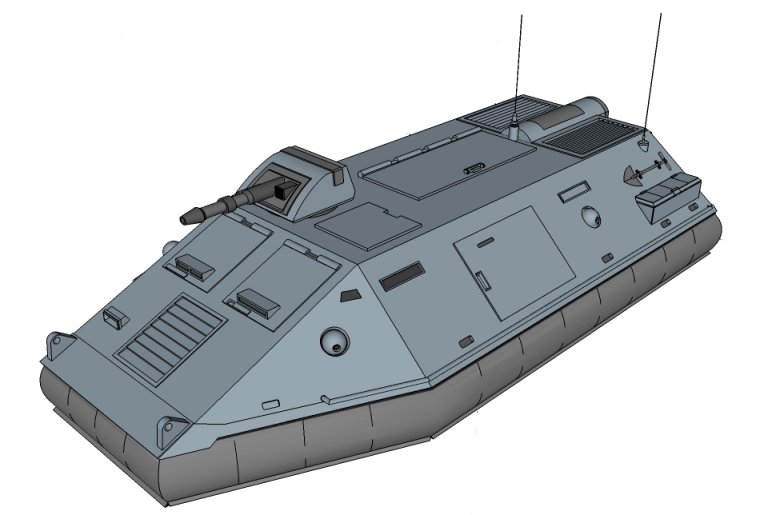
|
The Luftkissenpanzertrager-V
is the brother of the Kangaroo-IV, both designs having derived from the LkPzTr-IV. The LkPzTr-V addressed
the shortfalls of the LkPzTr-IV in a similar way to
the Australian design, more powerful powerplant, new
electronics and enhanced armour. The LkPzTr-V however
entered service more than half a decade later due to general satisfaction with
the earlier vehicle. The hull configuration of the LkPzTr-V
and Roo is almost identical, making identification particularly difficult. The
Bavarian fleet was primarily concentrated off world with the exception of
Panzer Kavallerie Regiments deployed as rapid
reaction units on earth. The Central Asian War came as a rude awakening
for the Bavarian military which had not had to fight on earth for many decades.
Its tracked armoured units designed for home defence were hard fighting, but
easily outmanoeuvred by the Manchurians and the PKRs
shouldered most of the combat burden while the regular units reequipped with hovermobile vehicles better suited to the Steppes. The LkPzTr-V was probably the best regarded Bavarian AFV of the
CAW but went through several modifications to enhance survivability. The LkPzTr-V Aufs E was the standard
HAPC in the Bavarian forces during the Reunification War with France and still
serves in most German reserve formations despite its replacement by the LkPzTr-VII and VII in regular formations. The LkPzTr-V Aufs E is also the standard HAPC in most German colonial
units still operating the LkPz-VIII hovertank. The German government retains a large war stock
of these vehicles, but was beginning to sell off its older Aufs
C and D models but is now retaining them to rebuild its colonial forces in the
wake of the Kafer invasion. The new Flemish Army has also received a
significant batch of LkPzTr-Vs. The Aufs E model,
designated LkPzTr-5E is also the frontline HAPC of the Freihafen military which
inherited a large fleet from Bavaria. The Freihafeners
are working on a modification of the design prior to the introduction of an
entirely new design. Freihafen factories continue low rate production of the 5E
to supply the growing Freiwehr and export customers. LkPzTr-V Aufs C
Type: Hover APC
Crew: Driver, gunner, commander
Weight 3500 kg Armor:
Plenum: 2 All Faces. 8
Armament: 25mm conventional autocannon in remote turret.
Signature: 5
Evasion: 6
Sensor
Range: 10 km
Range
Finder Bonus: +1
Cargo: 6 passengers and 2000 kg
Max
Speed: 200 kph
Cruising
Speed: 180 kph
Combat
Movement: 420 m
Off-Road
Mobility: Full
Power
Plant:
0.5 MW hydrogen fuel cell Fuel Capacity. 270 kg
Fuel
Consumption: 15 kg/hr
Endurance: 18 hr Price. Average price for a surplus LkPzTr-VC is Lv25 000. |
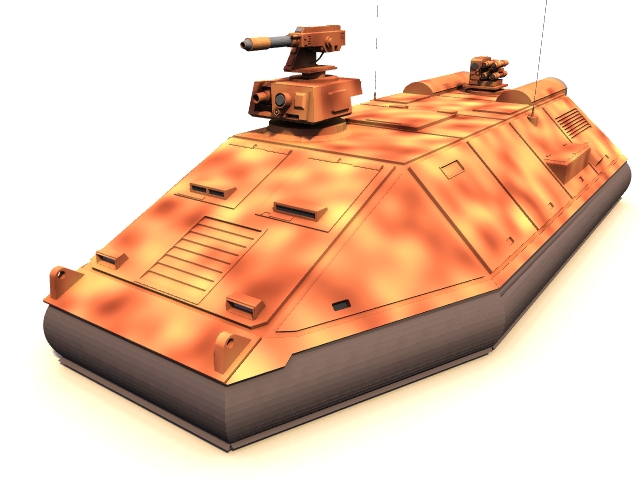
|
The Nantawarra is the Australian successor to
the Kangaroo-IV which came into service in 2273. The design was changed fairly
radically with the change from a single turbine powerplant
to two engines which allowed the installation of a rear ramp rather than the
Kangaroo’s side doors. The Nantawarra had a significantly more capable weapon
system than the Kangaroo including a 100MW laser system, 30mm grenade launcher
and rocket pack. This was not enough to put the vehicle into the HIFV class but
substantially increased its capability to support its infantry complement. The
Nantawarra also features enhanced armour and sensors. It has unusual crewing as
the commander/gunner position is combined and the spare position used to carry
a member of the command HQ. The Nantawarra was largely ahead of its time
and is still in service with the ADF in second line formations. Surplus
vehicles are now becoming available and it is believed that Australia and
Freihafen are vying to supply Tanstaafl with
additional and replacement APCs for its original,
hard used, Kangaroos. Nantawarra F35A3 Type: Hover APC Armour: plenum: 10, front: 40, overhead: 40, other faces: 20 |
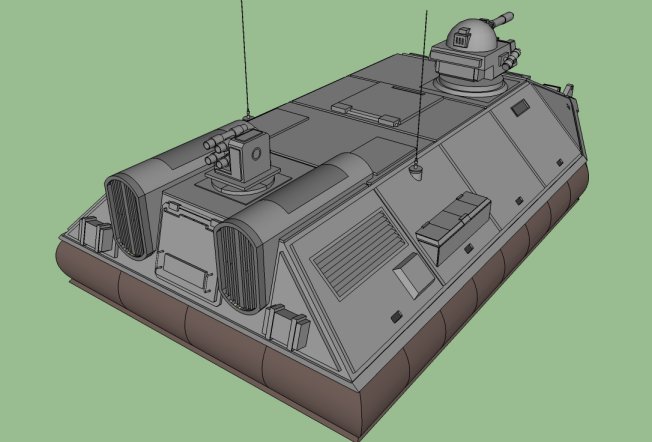
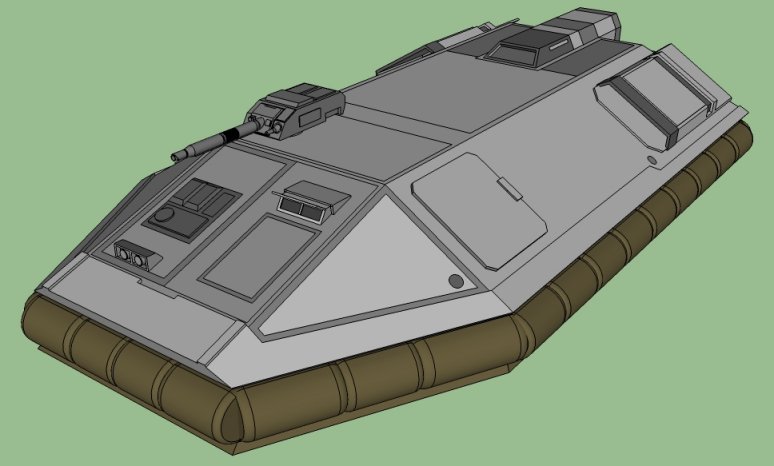
|
The Luftkissenspähpanzer-3
is a Freihafen design named after a nocturnal member of the Tiracat
family. A modification of the trusty LkPzTr-V the Shattenkatze is a very handy cavalry and reconnaissance
vehicle. It retains the innate sturdiness of earlier vehicle with enhanced stealth
and sensors including a tethered UAV system. Weapons include the CPL-1A plasma
cannon, a 7.5mm coaxial MG and a Luchs missile launcher
with a total of five rounds. The Luchs can be directed from the UAV or from a remote firing
post as well as conventionally. The Shattenkatze
has a crew of three, including driver, gunner and tactical commander. It has
the capability of carrying six passengers although normally only four troopers
are part of the vehicle teams. It is commonly deployed with Freiwehr PKRs and reconnaissance elements of other units. The
vehicle has yet to find a buyer outside of Freihafen, although Heidelsheimat may be close to signing a contract for a
number of vehicles. LkSpPz-3 Type: Hover Reconaissance Vehicle Armour: plenum: 8, front: 30, overhead: 30, other faces: 20
|
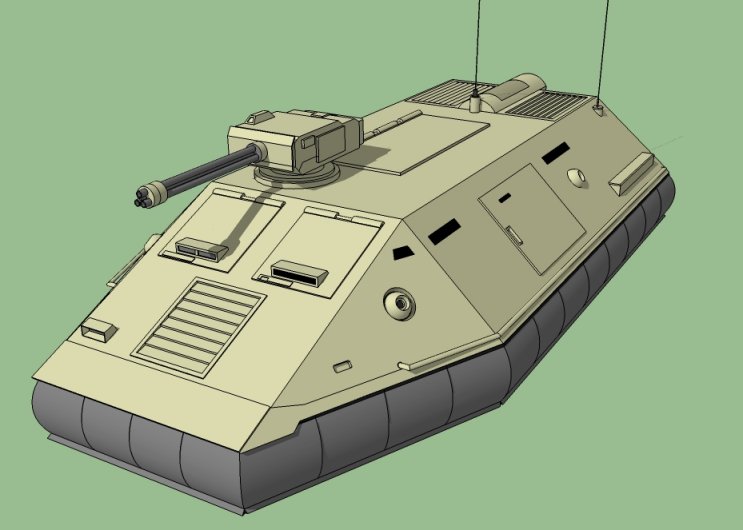
|
Kangaroo-IV AD The Air Defence version was developed by Australia to provide close in
air defence for mobile formations, primarily against UAVs
but also was able to provide defence against rocket, missile and artillery fire.
The Dunarmco Mk.8 plasma system provides rapid,
sustained and hard hitting fire out to two kilometres, allowing a group of four
vehicles to provide an effective point defence umbrella for key targets such as
a brigade HQ. This was usually practiced as part of an integrated air defence
system, as on their own the ADs
could be outranged or swamped by attackers. In practice the ADs also proved to be highly
effective in the ground attack role able to wreck havoc against both infantry
and light AFVs. This capability was shown on a number
of occasions during Australian peacekeeping missions in the Indian States.
Several operators of the Kangaroo have undertaken modifications to the AD
standard including the TFL which has no fewer than 8 ADs
which it uses to reinforce Ramrod missions in the direct fire role against
large concentrations of Kafers. Kangaroo-IV DS The versatility of the Kangaroo and its ease of modification led to
several private companies offering conversions. The French firm of Aerotech SA, based outside of Brussels, developed a missile
armed tank destroyer with two Aero-12 launchers, several re-loads and an
automatic reloading system. Attached to the LkPzTr-V
it became the LkPzJg-X and served as a light tank destroyer for the
Bavarians during the Central Asian War. It remained a popular conversion
through a number of years. A later mode, the DS2, doubled the number of ready
missiles mounted on the turret to four. The Flemish War of
Independence saw the Aerotech SA factory fall into
the territory of the new Republic of Flanders. Flanders has subsequently
modified many of its LkPzTr-Vs into the DS version as
part of its strategy in the event of French military intervention. The latest version has four Aero-12 missiles ready to
launch for rapid engagement of multiple targets. Dasne Light Hover Tank The Dasne, or dagger, is an Iranian modification of its Kangaroo APCs. Although it is designated as a light hover tank it could be more accurately described as a tank destroyer. The vehicle is modified with a hull mounted 80mm taken from CAR stocks captured by Iranian allied forces as well as Green Hunter ATGW. The Dasne is no match for most hovertanks but is effective when used in support of mechanised infantry against most AFVs.
Âzaraxs Light Hover Tank
The Âzaraxs is an Iranian light hovertank developed from the LkPzTr-V chassis and heavily modified with a hard hitting armament package including 75mm MDC, ATGW launcher and an array of secondary armaments. The fast moving Âzaraxs might lag behind more modern designs for pure combat effectiveness but its fast strike capability suits Iranian frontier units well.
Other Export Customers
The Kangaroo and LkPzTr-V have proved to be very popular export items over
the years and many are still in full time or reserve service in both the core
and the colonies. Mozambique in particular operates a large Kangaroo fleet
which still equips its reserve mechanised units, of which many were built
domestically. In South America Venezuela and the Incan Republic amongst others
still operate these vehicles, as do several almost perpetually warring Indian
States. Smaller users of these vehicles abound.
<TBC> |
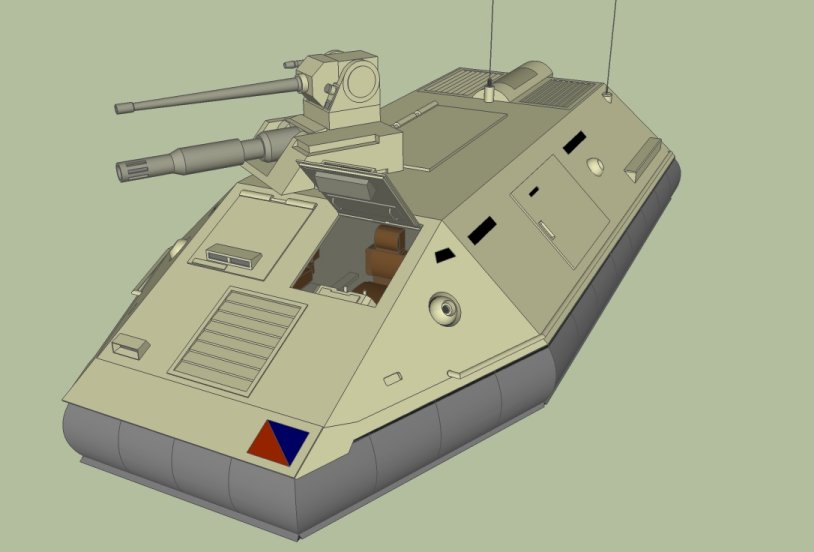
|
CPL-1A The
CPL-1A is
a Central Asian War era French heavy, rapid fire plasma cannon. It was
developed as a close range weapon system capable of rapid engagements of
Manchurian AFVs, combat walkers or infantry. It was
designed to work from a vehicle mount or a heavy ground tripod. It was
produced in large numbers during the war and is a robust and popular refitting
option on many light vehicles.
Type: 175 MW Plasma Cannon Fire Control: +1 Mark 8 Triple Plasma Gun The
Dunarmco Mk 8 is a gatling
style plasma cannon with three rotating barrels. It is an old, but
accurate design capable of sustained rates of fire against air and incoming
ordnance targets. It is also highly capable in the ground role against a range
of targets where it has been used with some success against the Kafers on a number of platforms. Type: 40 MW
three barrelled plasma gun Fire Control: +3
|
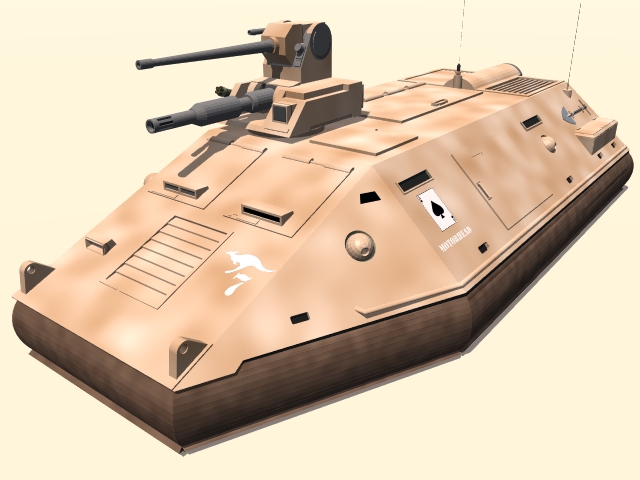
|
Kangaroo-IV, 7 Commando,
Tanstaafl Free Legion Thunder Valley, Tanstaafl, Aurore, 2nd October
2300 This plate shows a Kangaroo-IV of the TFL’s 7
Commando during the successful offensive at Thunder Valley in late 2300 when
the elite ‘Ramrod’ teams spearheaded the Tanstaaflian
assault. These vehicles were purchased as surplus at knock down rates from
Australia and with their simple but hard hitting armament are very popular with
their crews. The Kangaroo’s arrived still marked with the usual Australian red
kangaroos, which the ground crews modified into white kangaroos. TFL vehicles
are usually in a simple two tone camouflage but are frequently and often
modified by their users on the frontline, in this case in a mottled pattern useful on the edges of the Hotback. Other markings include the unit name,
ace of spades device and the nickname ‘Motorhead’,
LkPzTr-V Aufs
E, 2 Kompanie, Panzer Kavallerie
Regiment 8, IV Korps,
Bundeswehr Pforzheim, Baden-Württemberg,
Bavaria, 25th April 2293 This plate shows a LkPzTr-V
Aufs E of the German Army’s IV Corps during the War
of German Reunification immediately prior to entering combat against French
forces attacking towards Stuttgart. IV Korps
contained the bulk of the old Bavarian Army on Earth and PKR 8 was one of its
hard-hitting screening units which still contained a strong cadre of Central
Asian War veterans. PKR 8 would be involved in a number of heavy raids through
the Black Forest into the flanks of the French including an attack on their 13
Corps HQ area in Alsace. This LkPzTr-V is depicted in the standard
German blue-grey rapidly applied over the old Central Asian pattern previously
utilised by the regiment. The vehicle also carries the German iron cross as
well as the old Bavarian flag. The rearing horse design with eight stars is the
unit’s emblem carried over from the US unit that remained in Bavaria at the end
of WWIII almost three hundred years ago. |
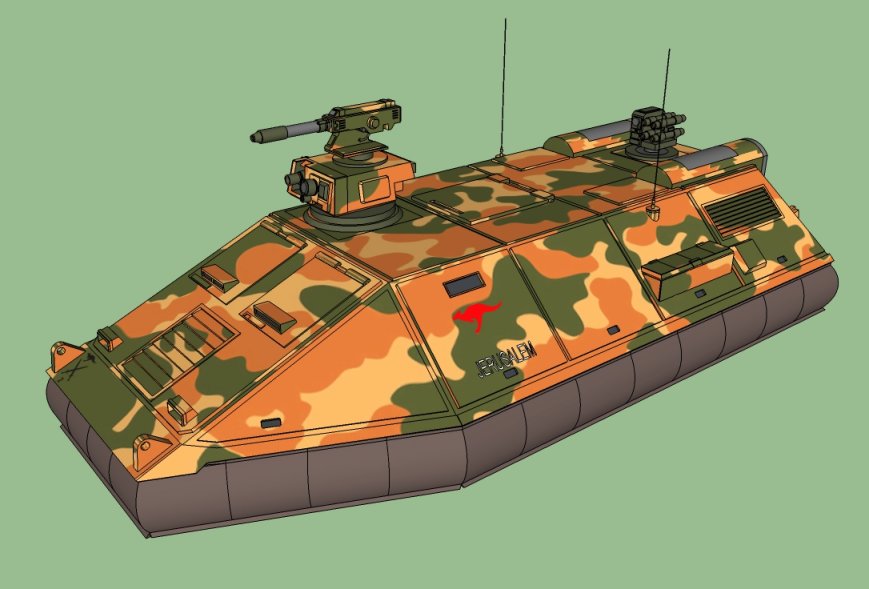
|
Nantawarra, 5th Queensland Mounted Infantry, 2nd Division, Australian Defence
Force Woomera, South Australia,
29th July 2299 This plate shows a Nantawarra of 5QMI on exercise in the Woomera
training area in South Australia. 2nd Division is a one of the Australian
Army’s reserve formations and as such it is equipped with the Nantawarra ‘A3’
model. The Nantawarra built on the successes of the original Kangaroo-IV while
increasing firepower, armour and power and is still a respectable combat
vehicle. The Natawarra is shown in a camouflage pattern
designed for use in the arid terrain that dominates much of Australia’s
interior. It carries the divisional identification symbol on the front of the
vehicle, the red kangaroo and the name ‘Jerusalem’ taken from one of the
regiment’s battle honours. |
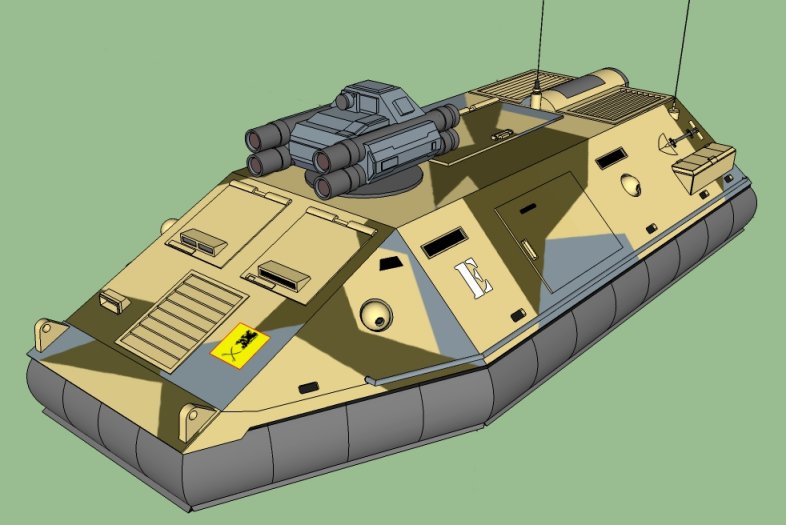
|
LkPzTr-5D DS2, Eskadron
B, 2de Regiment Gidsen,
1st Mechanised Division, Vlaams
Krijgsmacht Hoeilaart, Flanders, 3rd
January 2300 This plate shows an LkPzTr-5D DS of the Flemish Army’s 2nd Guides
Regiment, which is a reconnaissance unit attached to the 1st Division. These
vehicles are locally modified into the latest DS version as part of the Flemish
concentration on developing its anti-tank capability in case of French military
intervention. There are four of these vehicles supporting twelve standard
LkPzTr-5Ds in each of the regiment’s squadrons. These vehicles also serve in
mechanised infantry battalions. The Flemish use a standard disruptive pattern designed to conceal the
vehicles effectively in urban or rural environments. The vehicle is also marked
with the black lion of the Flemish Army and a vehicle indicator 'E'. The Nantawarra is by A Gubler. The Iranian Army models are by Jason Weiser and James Boschma. The original Kangaroo-IV is described in the Ground Vehicle Guide and the Aurore Sourcebook. Images are by Ian Stead.
Copyright 2010, Ian Stead and D Hebditch. 13 Feb 10 |
